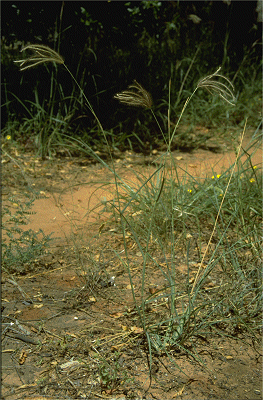 |
 |
|
 |
 |
|

Chloris inflata Link |
Common name
Purpletop Chloris
Purple-top Rhodes Grass
Derivation
Chloris Sw., Prodr. 25 (1788); from the Greek chloros (green),
referring to the leaves; alternatively, named for Chloris (The Green
One), mythological Greek goddess of flowers.
inflata- Latin for swollen. Lemmas swollen.
Published in
Enum. Pl 1: 105 (1821).
Common synonyms
Chloris barbata auct. non Sw.
Habit
Annual or perennial, tufted. Young shoots intravaginal, flabellate. Culms geniculately
ascending or decumbent, 20–100 cm tall. Mid-culm internodes elliptical
in section. Lateral branches simple or sparsely branched. Leaves mostly basal.
Ligule a fringed membrane, 0.3–0.6 mm long, truncate. Leaf-blades 4–40
cm long, 2–5 mm wide. Leaf-blade surface scaberulous. Leaf-blade apex attenuate,
filiform.
Inflorescence
Inflorescence digitate, with spicate branches. Spikes 5–20, unilateral,
4–8 cm long. Rhachis subterete. Spikelet packing broadside to rhachis,
regular.
Spikelets
Spikelets solitary. Fertile spikelets at least 3-flowered, comprising 1 fertile
floret, with diminished florets at the apex, cuneate, laterally compressed,
2–2.5 mm long, breaking up at maturity. Spikelets disarticulating below
each fertile floret. Floret callus bearded, obtuse, hairs 20–30% of length
of lemma.
Glumes
Glumes persistent, similar, thinner than fertile lemma, gaping. Lower glume
lanceolate, 1.2–1.5 mm long, 60% length of upper glume, membranous,
1-keeled, 1-nerved. Lower glume lateral nerves absent. Lower glume apex acute.
Upper glume lanceolate, 1.7–2.5 mm long, 100% of length of adjacent
fertile lemma, membranous, 1-keeled, 1-nerved. Upper glume lateral nerves absent.
Upper glume apex acute, mucronate.
Florets
Fertile lemma elliptic to oblong, laterally compressed, elliptic in profile
(narrowly), 2–2.5 mm long, cartilaginous, pallid, 3-nerved. Lemma midnerve
ciliate, hairy above. Lemma lateral nerves close to margins. Lemma margins ciliolate,
hairy all along. Lemma apex obtuse, 1-awned. Median (principal) awn subapical,
4.5–7 mm long overall, 200–300% of length of lemma, limb scaberulous.
Palea elliptic, 100% of length of lemma, 2-nerved. Palea apex obtuse. Apical
sterile florets 2. Apical sterile florets barren, separate, cuneate. Apical
sterile lemmas 1-awned. Apical sterile lemma awns 2.5–7 mm long, 2 per
spikelet. Lodicules 2, cuneate, fleshy. Anthers 3, 0.6–0.7 mm long. Stigmas
2. Grain with adherent pericarp, fusiform, dorsally compressed, trigonous, estipitate,
not grooved, 1.2–2 mm long, smooth, apex unappendaged. Embryo 75% of
length of grain. Hilum punctiform. Endosperm farinose.
Continental Distribution:
Africa, Temperate Asia, Tropical Asia, Australasia, Pacific, South America.
Australian Distribution:
Western Australia, Northern Territory, South Australia, Queensland.
Western Australia: Gardner, Fitzgerald, Hall, Dampier, Fortescue. Northern Territory: Darwin & Gulf, Victoria River, Barkly Tableland, Central Australia North, Central Australia South. South Australia: Lake Eyre. Queensland: Cook, Burke, North Kennedy, South Kennedy, Port Curtis, Leichhardt, Moreton, Gregory North, Mitchell.
Classification. (GPWG
2001):
Chloridoideae: Cynodonteae
Notes
Introduced.

Habit (photo)
© B. Carter